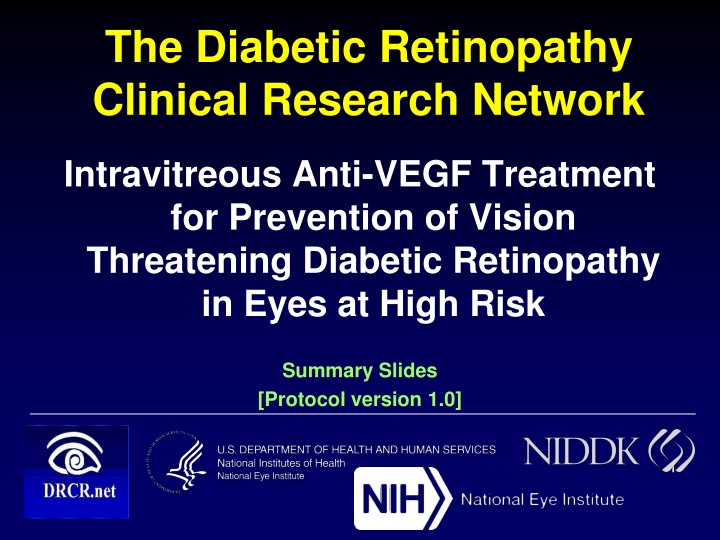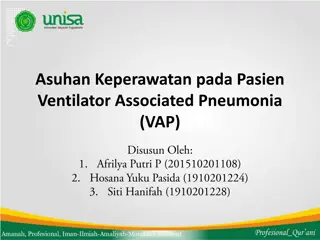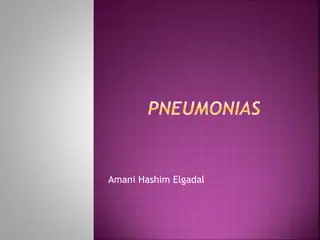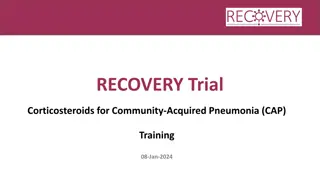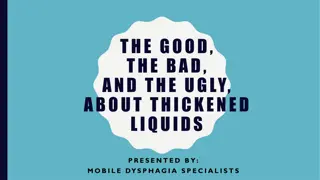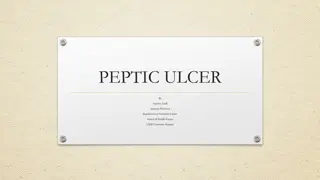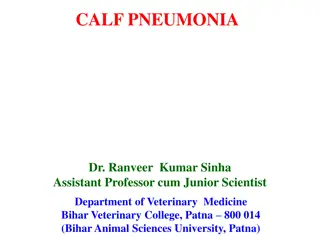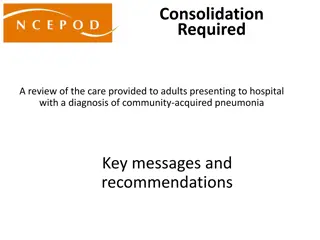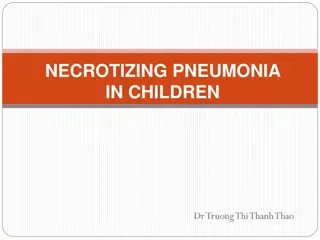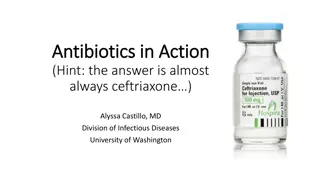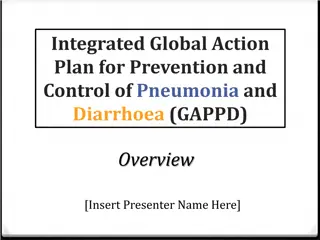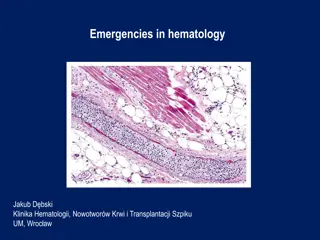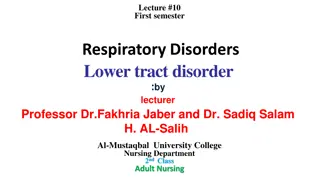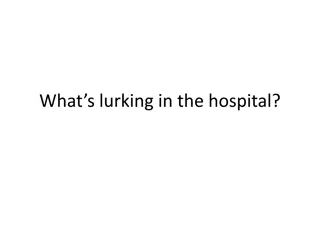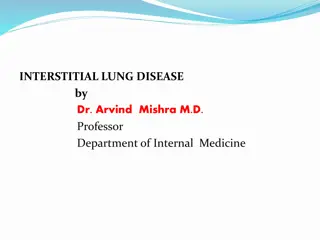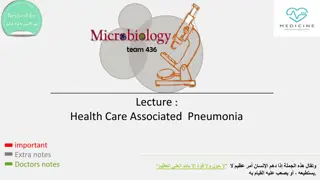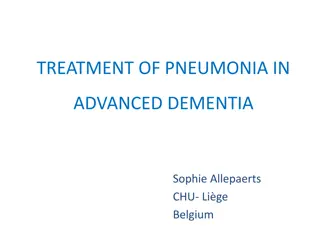Pneumonia - Causes, Symptoms, and Management
Pneumonia is an inflammatory condition of the lung caused by microbial agents. Learn about its definition, epidemiology, etiology, types, signs, symptoms, diagnostic evaluation, and management. Understand the common illness affecting millions worldwide and the various causes of pneumonia, including bacteria, viruses, fungi, and more. Recognize the signs and symptoms such as fever, cough, shortness of breath, and chest pain. Explore the diagnostic tools used to evaluate pneumonia and the treatment options available, including antibiotics and bronchodilators.
Download Presentation

Please find below an Image/Link to download the presentation.
The content on the website is provided AS IS for your information and personal use only. It may not be sold, licensed, or shared on other websites without obtaining consent from the author.If you encounter any issues during the download, it is possible that the publisher has removed the file from their server.
You are allowed to download the files provided on this website for personal or commercial use, subject to the condition that they are used lawfully. All files are the property of their respective owners.
The content on the website is provided AS IS for your information and personal use only. It may not be sold, licensed, or shared on other websites without obtaining consent from the author.
E N D
Presentation Transcript
The Diabetic Retinopathy Clinical Research Network Intravitreous Anti-VEGF Treatment for Prevention of Vision Threatening Diabetic Retinopathy in Eyes at High Risk Summary Slides [Protocol version 1.0] 1 1
DRCR.net Overview Objective: Collaborative network to facilitate multicenter clinical research of diabetic retinopathy, DME and associated conditions Funding: National Eye Institute (NEI) and The National Institute of Diabetes and Digestive and Kidney Diseases (NIDDK)-sponsored cooperative agreement initiated September 2002. oCurrent award 2014-2018 2
DRCR.net Status (as of 1/6/14) Active 119 Total 179 Sites (Community & Academic Centers) 80 (67%) 120 (67%) Community Sites Investigators Other Personnel States 363 979 37 786 2746 41 3
Prevention Study Background Eyes with severe non-proliferative diabetic retinopathy (NPDR) are at high risk for DR worsening and subsequent VA loss According to the Early Treatment Diabetic Retinopathy Study (ETDRS), of eyes with severe NPDR and no DME at baseline: 52% develop proliferative diabetic retinopathy (PDR) over 1 year 60% develop PDR with high-risk characteristics over next 5 years 4
Risk for Developing PDR in the ETDRS Event Rate 80% Severe NPDR Moderately severe 60% Moderate NPDR Axis Title 40% Mild NPDR 20% 0% Axis Title 0 1 2 3 4 5 Years
Background Although some eyes may benefit from early PRP, there is currently no clear treatment mandate for severe NPDR Deferred Scatter Early Scatter Type 2 Risk of Severe Visual Loss or Vx 10% Type 1 5% Type 2 P=0.43 P=0.0001 0% 0 1 2 3 4 5 Years P (Interaction) = 0.0002 Ferris F. Early photocoagulation in patients with either type I or type II diabetes. Trans Am Ophthalmol Soc. 1996;94:505-37.
More Recent Data: DRCR.net Trial Laser Groups (with DME at baseline) Proportion with PDR at 2 Years by Baseline Level of Retinopathy 40% N = 21 N = 41 N = 17 38% 35% 37% 36% N = 45 30% 31% 25% 20% N = 46 15% 16% N = 32 10% 10% 5% 0% Protocol A Protocol B Protocol I Severe NPDR Moderate NPDR 7
DRCR.net Protocol I: Comparison to Anti-VEGF Treated Eyes Proportion with PDR at 2 Years 40% N = 21 N = 17 38% 35% 36% 30% 25% 20% 15% N = 22 10% 12% N = 88 5% 6% 0% Severe NPDR Laser Group Moderate NPDR Ranibizumab Groups 8
RISE/RIDE: Risk of PDR Outcomes in Sham vs Ranibizumab Groups Time to First Progression to PDR Outcome 3 fold higher risk in sham group Months Cumulative probabilities calculated using the Kaplan-Meier method. Progression was defined by (1) progression from NPDR (DR severity level < 60) at baseline to PDR (DR severity level 60) at a later time point, (2) need for PRP laser, (3) vitreous hemorrhage (AE or slit lamp grade 0 at baseline to > 0 at a later time point, (4) cases identified by ophthalmoscopy, (5) vitrectomy, (6) iris neovascularization AE, or (7) retinal neovascularization AE. 1 month = 30 days. AE, adverse event; PRP, panretinal photocoagulation.
Proportion of Patients Requiring PRP From Baseline to Week 100 VIVID VISTA Proportion of patients 154 155 152 133 136 135 PRP: Panretinal Photocoagulation IAI: Intravitreal Aflibercept Injection
DME Development Eyes with severe NPDR and no center- involved (CI) DME at baseline are also at risk for developing DME requiring anti- VEGF treatment 15% in ETDRS developed CI-DME on photos by 2 years DRCR.net Protocol R included eyes with non-CI DME and any level of retinopathy and 14% developed CI-DME on OCT or required treatment by 1 year 11
Primary (Short-term) Objective To determine safety and efficacy of prompt anti-VEGF versus observation in eyes presenting with severe NPDR and no CI-DME for prevention of vision threatening outcomes Observation (sham injections) Intravitreous anti-VEGF Primary outcome: Proportion of eyes that develop PDR/PDR-related outcomes or center-involved DME causing visual acuity loss at 2 years 1 2
Long-term Objectives If there is a clinically important difference identified among the treatment groups for the primary outcome at 2 years, the study will also evaluate whether increased chance of prevention of PDR/DME with anti-VEGF at 2 years results in long-term beneficial visual outcomes at 4 years. 13
Summary of Rationale The application of anti-VEGF therapy earlier in the course of disease could help to reduce future potential treatment burden in patients, at the same time resulting in similar or better long- term visual acuity outcomes. If this study demonstrates that anti-VEGF treatment is effective and safe in the setting of severe NPDR, a new strategy to prevent vision- threatening complications will be available for patients. 14
Follow-Up and Treatment Overview Total duration: 4 years Visits at 1, 2, and 4 months; every 4 months thereafter Injections (intravitreous or sham) required at each of the above visits through 2 years and subsequently based on DR severity level If PDR or DME develop, visits may be more frequent for standardized treatment with intravitreous anti-VEGF 15
Major Inclusion/Exclusion Criteria in Study Eye Severe NPDR (ETDRS level 53) according to investigator 4-2-1 rule oSevere hemorrhages in at least 4 quadrants, or oDefinite venous beading in at least 2 quadrants, or oModerate IRMA in at least 1 quadrant Vision 20/25 or better No center-involved DME on OCT No history of DME/DR treatment in prior 12 months and <4 prior injections at any time No prior PRP 16
Thank You on Behalf of Diabetic Retinopathy Clinical Research Network (DRCR.net) Dedicated to multicenter clinical research of diabetic retinopathy, macular edema and associated disorders. 17
